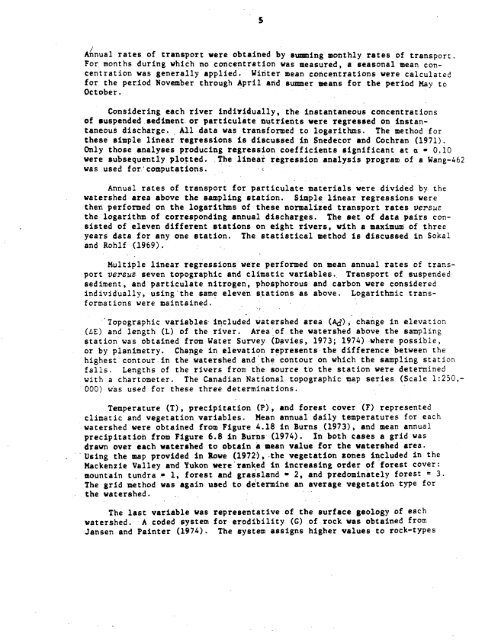The chemistry, mineralogy, and rates of transport of sediments in the ...
The chemistry, mineralogy, and rates of transport of sediments in the ...
The chemistry, mineralogy, and rates of transport of sediments in the ...
Create successful ePaper yourself
Turn your PDF publications into a flip-book with our unique Google optimized e-Paper software.
Annual <strong>rates</strong> <strong>of</strong> <strong>transport</strong> were obta<strong>in</strong>ed by summ<strong>in</strong>g monthly <strong>rates</strong> <strong>of</strong> <strong>transport</strong> .<br />
For months dur<strong>in</strong>g which no concentration was measured, a seasonal mean concentration<br />
was generally applied . W<strong>in</strong>ter mean concentrations were calculated<br />
for <strong>the</strong> period November through April <strong>and</strong> summer means for <strong>the</strong> period May to<br />
October .<br />
Consider<strong>in</strong>g each river <strong>in</strong>dividually, <strong>the</strong> <strong>in</strong>stantaneous concentrations<br />
<strong>of</strong> suspendedr<br />
sediment. or particulate nutrients were regressed on <strong>in</strong>stantaneous<br />
discharge ., All data was transformed to logarithms . <strong>The</strong> method for<br />
<strong>the</strong>se simple l<strong>in</strong>ear regressions is discussed <strong>in</strong> Snedecor <strong>and</strong> Cochran (1971) .<br />
Only those analyses produc<strong>in</strong>g regression coefficients significant at a - 0 .10<br />
were subsequently plotted . <strong>The</strong> l<strong>in</strong>ear regression analysis program <strong>of</strong> a Wang-462<br />
was used for.' computations .<br />
t<br />
Annual <strong>rates</strong> <strong>of</strong> <strong>transport</strong> for particulate materials were divided by <strong>the</strong><br />
watershed area above <strong>the</strong> sampl<strong>in</strong>g station . Simple l<strong>in</strong>ear regressions were<br />
<strong>the</strong>n performed on <strong>the</strong> logarithms <strong>of</strong> <strong>the</strong>se normalized <strong>transport</strong> <strong>rates</strong> versus<br />
<strong>the</strong> logarithm <strong>of</strong> correspond<strong>in</strong>g annual discharges . <strong>The</strong> set <strong>of</strong> data pairs consisted<br />
<strong>of</strong> eleven different stations on eight rivers, with a maximum <strong>of</strong> three<br />
years data for any one station . <strong>The</strong> statistical method is discussed <strong>in</strong> Sokal<br />
<strong>and</strong> Rohlf (1969) .<br />
Multiple l<strong>in</strong>ear regressions were performed on mean annual <strong>rates</strong> <strong>of</strong> <strong>transport</strong><br />
versus seven topographic <strong>and</strong> climatic variables . . Transport <strong>of</strong> suspended<br />
sediment, <strong>and</strong> particulate nitrogen, phosphorous <strong>and</strong> carbon were considered<br />
<strong>in</strong>dividually, us<strong>in</strong>g - <strong>the</strong> same eleven stations as above . Logarithmic transformations<br />
were ma<strong>in</strong>ta<strong>in</strong>ed .<br />
Topographic variables <strong>in</strong>cluded watershed area (Ad), change <strong>in</strong> elevation<br />
(LE) <strong>and</strong> length (L) <strong>of</strong> <strong>the</strong> river . Area <strong>of</strong> <strong>the</strong> watershed above <strong>the</strong> sampl<strong>in</strong>g<br />
station was obta<strong>in</strong>ed from Water Survey (Davies, 1973 ; 1974) • where possible,<br />
or by planimetry . Change <strong>in</strong> elevation represents •<strong>the</strong> difference between <strong>the</strong><br />
highest - contour-<strong>in</strong> <strong>the</strong> watershed <strong>and</strong>' <strong>the</strong> contour on which <strong>the</strong> sampl<strong>in</strong>g station<br />
falls . Lengths <strong>of</strong> <strong>the</strong> rivers from <strong>the</strong> source to <strong>the</strong> station were determ<strong>in</strong>ed<br />
with a chartometer . <strong>The</strong> Canadian National topographic map series (Scale 1 :250,-<br />
000) was used for <strong>the</strong>se three determ<strong>in</strong>ations .<br />
Temperature (T), precipitation (P), <strong>and</strong> forest cover (F) represented<br />
climatic <strong>and</strong> vegetation variables . Mean annual daily temperatures for each<br />
watershed were obta<strong>in</strong>ed from Figure 4 .18 <strong>in</strong> Burns, (1973), <strong>and</strong> mean annual<br />
precipitation .from Figure 6 .8 <strong>in</strong> Burns (1974) . In both cases a grid was<br />
drawn over each watershed to obta<strong>in</strong> a mean value for <strong>the</strong> watershed area .<br />
Us<strong>in</strong>g <strong>the</strong> map provided <strong>in</strong> Rowe (1972), •<strong>the</strong> vegetation zones <strong>in</strong>cluded <strong>in</strong> <strong>the</strong><br />
Mackenzie Valley <strong>and</strong> Yukon were'ranked <strong>in</strong> <strong>in</strong>creas<strong>in</strong>g order <strong>of</strong> forest cover :<br />
mounta<strong>in</strong> tundra .- 1, forest <strong>and</strong> grassl<strong>and</strong> = 2, <strong>and</strong> predom<strong>in</strong>ately forest - 3 .<br />
<strong>The</strong> grid method was aga<strong>in</strong> used to determ<strong>in</strong>e an average vegetation type for<br />
<strong>the</strong> watershed .<br />
<strong>The</strong> last variable was representative <strong>of</strong> <strong>the</strong> surface geology <strong>of</strong> each<br />
watershed . A coded system for erodibility (G) <strong>of</strong> rock was obta<strong>in</strong>ed from<br />
Jansen <strong>and</strong> Pa<strong>in</strong>ter (1974) . <strong>The</strong> system assigns higher values to rock-types
















